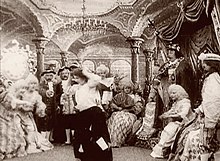Cinderella.Com By River Laurent Free Pdf Download
| Cinderella | |
|---|---|
 A scene from the pic | |
| Directed by | Georges Méliès |
| Based on | Cinderella by Charles Perrault |
| Produced past | Georges Méliès |
| Starring |
|
| Release dates |
|
| Running fourth dimension | 6 minutes |
| Country | France |
Cinderella (French: Cendrillon ) is an 1899 French film directed by Georges Méliès, based on the fairy tale past Charles Perrault. It was released by Méliès's Star Moving-picture show Visitor and is numbered 219–224 in its catalogues, where information technology is advertised as a grande féerie extraordinaire en 20 tableaux.[1]
Cast [edit]
The casts of Méliès'south films are in many cases unidentified. Nearly of the following listing is based on cast identifications fabricated by the film scholars Georges Sadoul, Jacques Malthête, and Laurent Mannoni.[1]
- Mlle Barral every bit Cinderella.[one] Barral had also acted in Méliès's sleeping room farce The Bridegroom's Dilemma earlier that year.[ii]
- Bleuette Bernon as the Fairy Godmother.[3] Méliès discovered Bernon in the 1890s, when she was performing as a vocalist at the cabaret L'Enfer. Her appearance in Cinderella is contemporaneous with her performances at the Eldorado cabaret. She as well appeared as Phoebe, the adult female on the crescent moon, in Méliès's famous A Trip to the Moon.[4]
- Carmelli as the Prince.[three] Carmelli was an histrion at Méliès's theater of stage illusions, the Théâtre Robert-Houdin in Paris.[five]
- Jehanne d'Alcy as the Prince's mother, the Queen.[1] D'Alcy had achieved success in theatrical productions by 1896, but left the stage to devote herself to film, condign one of the beginning performers to do and then. She appeared in many of Méliès's films and after became his second wife.[iv]
- Dupeyron as a party invitee.[1]
- Georges Méliès every bit the genie of the midnight clock, and as a halberdier.[one] All told, Méliès took an acting office in at least 300 of his 520 films.[vi]
Production [edit]

Méliès modeled the flick'southward visual style on the engravings of Gustave Doré, who had illustrated the story for an edition of Perrault's fairy tales. (Doré was stylistically influential across Méliès's career, especially in this motion picture and in his picture show adaptations of four other works Doré had illustrated: Ruby Riding Hood, Blue Beard, The Wandering Jew, and Baron Munchausen's Dream.)[7] The direct inspiration for the film of Cinderella was probably a phase adaptation premiered in 1896 past the Théâtre de la Galerie-Vivienne and played by the Troupe Raymond at Méliès's own theatre of illusions, the Théatre Robert-Houdin, at Christmastime of 1897.[eight] Méliès may also accept been inspired by the Théâtre du Châtelet's lavish 1895 stage production of the story.[9]
Cinderella was Méliès's kickoff film with multiple scenes (tableaux), using six singled-out sets and five changes of scene within the picture. (His catalogue, by dividing the action into smaller beats, lists twenty tableaux within the film, a generous numbering probably devised for publicity reasons.)[1] So many extras were used in Cinderella that Méliès designated a Main Extra to lead them.[4] The film'due south special effects were created with multiple exposures, dissolves, and commutation splices.[x]
Reception [edit]
Cinderella was Méliès's first major cinematic success.[11] It did well both in French fairground cinemas and at European and American music-halls, and inspired Méliès to create other lavishly designed storytelling films with multiple scenes.[8] His next movie with multiple scenes, Joan of Arc (1900), was his first to surpass 200 meters of flick in length, and was also a marked success.[xi] Co-ordinate to the flick historian Lewis Jacobs, Cinderella'due south employ of spectacle on screen as well influenced the films of Cecil B. DeMille.[8]
Méliès fabricated another accommodation of the story, Cinderella or the Glass Slipper, in 1912 under the supervision of Pathé Frères. This version was not a success, partially because of directorial disharmonize between Méliès, Ferdinand Zecca, and Charles Pathé, and partially considering Méliès's theatrical style had fallen out of fashion by 1912.[viii]
References [edit]
- ^ a b c d eastward f one thousand Malthête, Jacques; Mannoni, Laurent (2008). L'oeuvre de Georges Méliès. Paris: Éditions de La Martinière. pp. 101–102. ISBN9782732437323.
- ^ Malthête & Mannoni, p. 94
- ^ a b Bertrand, Aude (2010), Georges Méliès et les professionnels de son temps (PDF), Université de Lyon, p. 117, retrieved 20 December 2014
- ^ a b c Wemaere, Séverine; Duval, Gilles (2011). La couleur retrouvée du Voyage dans la Lune. Groupama Gan Foundation for Cinema and Technicolor Foundation for Cinema Heritage. p. 165. Retrieved 10 August 2013.
- ^ Bertrand 2010, p. 48
- ^ Malthête & Mannoni, p. 88
- ^ Frazer, John (1979). Artificially Arranged Scenes: The Films of Georges Méliès. Boston: Chiliad. K. Hall & Co. p. 16. ISBN0816183686.
- ^ a b c d Frazer, p. 220
- ^ Frazer, p. 7
- ^ Essai de reconstitution du catalogue français de la Star-Flick; suivi d'une analyse catalographique des films de Georges Méliès recensés en France. Bois d'Arcy: Service des archives du pic du Centre national de la cinématographie. 1981. p. 83. ISBN2903053073. OCLC 10506429.
- ^ a b Malthête & Mannoni, p. 106
External links [edit]
- Cinderella at IMDb
- Cinderella is available for free download at the Internet Archive
DOWNLOAD HERE
Posted by: reillymagning.blogspot.com
Post a Comment